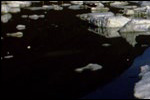| This
is my summary of what I have found about corporations
The Alaska Native Claim Settlement Act divided land in Alaska
among several Alaskan corporations, private property, governmental,
and National parks. These lands fall on top of each other. This
means that the Arctic National Wildlife Refuge and the 1002
area, is a National park, yet there are spots of land that are
territories of Native corporations. These spots of land include
primarily the villages of native Alaskans. These areas are creating
the greatest controversy, because they are corporately owned,
so the corporations feel that they should be able to do whatever
they please with this area, but they are also in a federally
protected area, so certain limitations are in place. On the
North Slope The Arctic Slope Regional Corporation (ASRC) is
in control of the land. This includes the 1002 region approximately
half of ANWR. The Doyon company is in charge of the largest
area of land in Alaska and is in charge of the rest of ANWR.
The actions of each company directly affects the other company,
because they are so close to each other, and share the same
types of resources.
Corporations want to drill for oil, because it will profit their
company, however, native corporations, which are owned by the
natives that live in the area, are concerned about the condition
of the environment and the health of their people. The ASRC
has several underlying diversified companies including; ASRC
Energy Services and Petro Star which are primarily concentrated
on oil drilling, Alaska Growth Capital which is a banking system,
and Top of the World Hotel which is a tourist enterprise that
depends on a pristine wilderness. Doyon has corporations that
are just as varied such as; Doyon Tourism, Doyon Drilling, Lands
and Natural Resources, and The Doyon Foundation which has an
emphasis on the well-being of Native Alaskans. If the native
corporations were solely concerned in obtaining oil, one would
think they are completely for oil exploration in the 1002 area,
but the corporations also know that there are sites in Alaska
with oil. For example, the ASRC stated in their 2002 annual
report, “ASRC will continue to advocate for development
of our resources in the coastal plain of the Arctic National
Wildlife Refuge (ANWR), but ANWR is not the only egg in the
basket. With opposition in Congress still a barrier to ANWR,
oil industry attention is now focusing on the National Petroleum
Reserve Alaska (NPR-A). The Company strongly supports exploration
and development in the NPR-A because of the jobs and other economic
boost it would give to our region.” (pg. 4).
In addition, Deborah Williams, part of the Alaska Conservatory,
pointed out that the Alaskan government does not acquire taxes
from it's people, or companies, and that there is no tourism
fee. Several cruises place Alaska as their main destination
every season. As stated earlier, the corporations are concerned
in tourism, and those branches of the corporation could expand
and profit form an inflated tourism program. The Alaskan government
likes the prospect of drilling because they obtain royalty revenue
from the drilling corporations, but they can also obtain revenue
from other means such as tourism.
Drilling affects families because when one or more parent is
away from their family for an extended amount of time, it will
effect that family, possibly quite detrimentally. Workers will
live at the drilling site for long shifts. They have to live
on site for such extended time periods, because of the length
of the commute to get to the drilling site. Traditionally, shifts
last around from two to four weeks at a time. It is not the
optimal setting to raise a child in a home that has one or more
of it's caretakers being gone for this amount of time.
|



